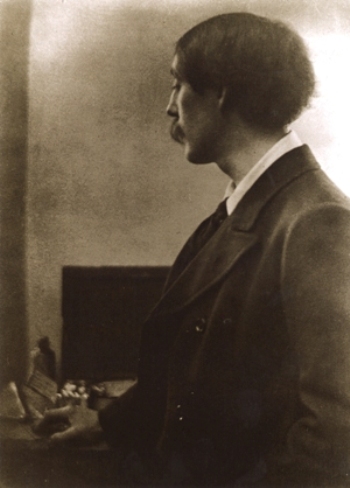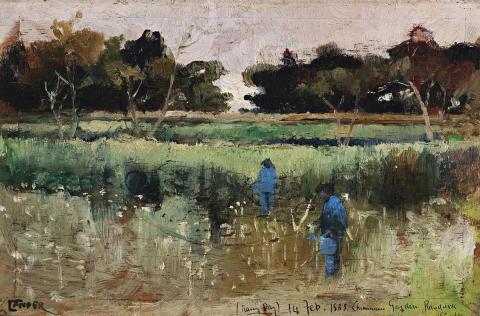RAINY DAY, 1888
CHARLES CONDER
oil on cedar cigar box lid
12.0 x 19.0 cm
signed lower left: C. CONDER
signed, dated and inscribed with title lower right: (Rainy Day) 14 Feb. 1888. Chinamans Garden. Randwick / C. E. Conder
bears cigar maker’s label verso: Heinrich Peemoller, Hamburg
Alfred S. McMichael, Melbourne (label attached verso)
Mrs K. Lyttleton Taylor, New South Wales
Christie’s, Sydney, 3 October 1989, lot 547
James O. Fairfax AC, New South Wales
Thence by descent
Private collection, New South Wales
Loan exhibition of Australian art: collection of paintings and drawings by Australian artists executed during the last 25 to 35 Years, Art Gallery of New South Wales, Sydney, 4 April 1918, cat. 7
Loan exhibition, National Gallery of Victoria, Melbourne, 1925, cat. 295
Art Gallery of New South Wales, Sydney, 1926 (no catalogue available)
Mixed Spring Exhibition, Grosvenor Galleries, Sydney, September 1946
Exhibition of Nine By Five Impressions, Grosvenor Galleries, Sydney, 5 December 1950
Charles Conder: 1868-1909, National Gallery of Victoria, Melbourne, 9 August – 4 September 1966; Art Gallery of New South Wales, Sydney, 9 November – 4 December 1966; and touring other state galleries, cat. 15
loaned to the National Gallery of Victoria for the opening exhibition of Ian Potter Centre: NGV Australia, Melbourne, October 2002 (label attached verso)
Hoff, U., Charles Conder, Lansdowne Press, Melbourne, 1972, [c13], p. 99
Eagle, M., The Oil Paintings of Charles Conder in the National Gallery of Australia, National Gallery of Australia, Canberra, 1997, p. 37 (illus. in installation)
Lane, T., ‘The 9 By 5 Impression Exhibition – The Challenge of the Sketch’, Australian Impressionism, National Gallery of Victoria, Melbourne, 2007, fig. 2, pp. 158 – 159 (illus.)
Rain! Who was painting rain in sunny Australia in the late 1880s? This was the land celebrated for its strong clear light sought out by artists from the northern hemisphere as well as the locally born, all of whom celebrated an aesthetic of sunny optimism. Yet here we see the twenty-year-old Sydney artist Charles Conder invoking something quite different; a nondescript landscape and a weather event that has nothing to do with the nascent nationalism currently dominating landscape painting. Instead Conder’s small cedar panel celebrates one of nature’s subtler moods – the beauty of a watery world. The view appears to be a spontaneous moment rather than a constructed landscape and is inscribed ‘Rainy Day 14 Feb. 1888. Chinamans Garden. Randwick’. His palette is tonal and restrained, lit up by the intense ultramarine blues of the costumes worn by the Chinese market gardeners.
Rainy Day, 1888 marks the moment when the young artist broke with the highly-coloured, illustrative mode of plein air landscape painting as practised by his teachers Alfred J. Daplyn and Julian Ashton, and established his artistic independence. For Rainy Day is virtually subjectless. It tells no story and describes no incident. Its meaning lies in its aesthetic: the exquisitely crafted brushwork leading the eye into the pictorial space via a variety of brushstrokes.
13 - CHARLES CONDER IN HIS STUDIO, c. 1904.jpg

Why did he choose to paint something so different from his usual practice? The answer lies in the contact he had recently made with Italian artist Girolamo Nerli who exhibited his ‘macchiaioli’ inspired work at the December 1887 exhibition of the Art Society of New South Wales. Nerli had studied in Florence, the home of the Macchiaioli school in the early 1880s, and had come to Melbourne in 1885, then Sydney in 1887. Conder visited his studio to see more of his work and his collection of Macchiaioli works.They proved a revelation. Here was a different approach – privileging the expressive power of the effects of natural light and shadow, and a new way of painting, with dabs and dabs of paint, ‘macchi’, rapidly applied with a limited palette. Mood, and weather conditions were subjects in their own right. Conder’s previous painterly practice of graphically outlining forms before adding colour, grounded as it was in his work for the Illustrated Sydney News, Sydney was challenged by Nerli’s apparently spontaneous application of brushstrokes and blobs. Echoes of the Italian’s A Wet Evening, 1888 – a bold study of a wet street with an approaching steam train and reflected figures crossing the roadway1 – can be seen in Conder’s The Gray and Gold, 1888,2 depicting a couple walking down a rain soaked street at sunset silhouetted by cloud-like daubs of gold and pink; and six months after Rainy Day the ambitious, rain drenched Departure of the Orient – Circular Quay, 18883 which won acclaim when exhibited with the Art Society of New South Wales in September that year and was acquired by the Art Gallery of New South Wales. The proceeds enabled Conder to leave for Melbourne in October taking Rainy Day with him, where it was purchased by local collector Alfred S. McMichael.
While Conder’s primary focus was the moody atmosphere of the scene, the subject itself is of significant historical interest. As the inscription notes, it was painted at Randwick, a short distance from Sydney to the south, in an area where sandy, alluvial soils saw the establishment of extensive market gardens from the 1830s. Contributing to the supply of fresh food for the growing settlements of New South Wales, the market gardens were originally tended by Europeans, however the influx of Chinese settlers during the gold rush gradually saw this change so that by the 1880s, when Conder painted this work, they were predominantly run by Chinese immigrants. Important signifiers of the rich cultural diversity of Australia’s history, several market gardens still operating in La Perouse, within the city of Randwick, have recently been listed on the State Heritage Register.
1. oil on board, 32.2 x 40.3 cm, New England Regional Art Museum, New South Wales
2. oil on wood panel, 40.7 x 28.7 cm, National Gallery of Australia, Canberra
3. oil on canvas, 45.1 x 50.0 cm, Art Gallery of New South Wales, Sydney
ANN GALBALLY
Professorial Associate in Art History, School of Culture and Communication, University of Melbourne
